As the world moves towards environment-friendly consumption, the demand for home gardening is rapidly increasing. So, if you’re looking to turn your backyard into a personal little veggie garden, we have some of the best rear tine garden tillers for you.
Tine Tillers have been here for ages. These are powerful yet handy equipment that can make your tilling experience more enjoyable than laborious. So, you can dig deep and prepare the most challenging soil and rocky terrains into beautiful landscapes and gardens.
Essentially, tine tillers can give a new definition to your gardening space. There are several options in terms of size, power, price, and features. So, it should help make a better decision, right? Well, not exactly.
Having so many brands is great, but at the same time, beginners can find it too confusing to buy the right product. Therefore, we have shortlisted some of the best options in our guide.
With a narrowed-down list, not only can you make a better decision, but it also saves your time on research. Moreover, we also have a buying guide for you to help buy the right rear tine tiller every time.
What is a Rear Tine Tiller?
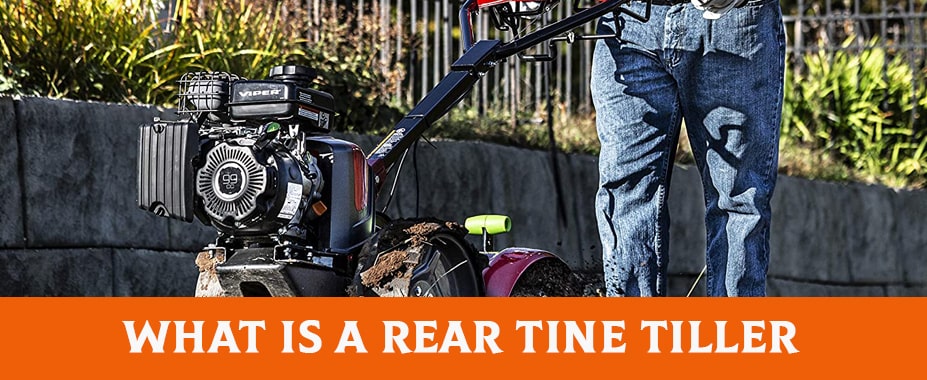
If you’re new to gardening, you may be hearing this word for the first time. A Rear Tine Tiller performs ground tilling with robust tines. These machines can dig deep holes of various sizes to help plant trees and crops.
Rear Tine Tillers attaches to the rear of the machine. So, they can generate more power as compared to the other tine tillers. Therefore, Rear Tine Tillers primarily come in handy for high-power applications.
Because they are so powerful, they can rip through clay, sod, and rocks. Hence, they are one of the preferred options for commercial tilling jobs.
There are Three Main Types of Rear Tine Tillers According to the Rotation Mechanism.
- Forward Rotating Tine Tillers
- Counter-Rotating Tine Tillers
- Dual-rotating Tine Tillers
Our Top Pick Best Rear Tine Tillers
Best Rear Tine Tillers Reviews
Now, it’s time to put each of the tine mentioned above tillers under the microscope. We will see what each of these units have to offer. The reviews should help you make a calculated decision about your next rear tine tiller. So, let’s have a look
1. Champion Dual Rotating Rear Tine Tiller
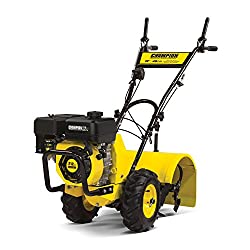
Champion 19-inch Dual Rotating Rear Tine Tiller is one of the best rear tine tillers under $1000. It gives a competitive advantage over other tillers in the same price range, thanks to its powerful 212cc engine. Because of its best dual rotating rear tine tiller design, it digs at a rapid speed.
The build material is one of the prominent features of this rotating tiller. Since it’s a heavy-duty design, the body’s fabric provides much-needed protection during a heavy workout. Moreover, the tines comprise hardened steels, so they dig through the most challenging soil with ease.
It can dig 19-inch-wide holes up to 8 inches deep. Moreover, it’s quite flexible, thanks to its switch operated direction control.
A pair of self-propelled 13-inch agricultural wheels make it easy-to-move on any terrain. Therefore, it’s a convenient option for small and large gardens, rocky surfaces, and mud.
The unit runs on gasoline and features exciting features like depth adjustment for consistent depth, low-oil shut-off, etc.
Highlighted Features
– low-oil shut off
– 19-inch tilling width.
– 212cc Gasoline powered engine.
– Gear Driven transmission.
– Self-propelled wheels.
– Counter-rotating tines.
– Depth adjustment.
– Heavy-duty design.
2. EARTHQUAKE 33970 Victory Rear Tine Tiller

The Earthquake 33970 Victory can shake things up in your backyard. If you’re looking for a heavy-duty arear-tine tiller for sale, it’s a great option. With a might 212cc Viper engine, the Earthquake can quickly bust through tough sod and clay-based mud.
Because of the rapid action, it can complete the tilling jobs much sooner. Moreover, it’s easy to operate, allowing you to reverse with a lever-action instantly.
For a heavy-duty tiller, it’s quite flexible. So, you can work tight corners and small gardens seamlessly. You can also adjust the height to three different levels. It promises a digging depth up to 10 inches with 16-inch wide holes.
Whether it’s tilled ground or virgin land, it can work wonders on most terrains. Powered by a gear drive transmission system, the steel tines help dig deep and enhance its durability.
Highlighted Features
– Three-level height adjustment.
– 10-inch digging depth.
– Instant reversing.
– 212CC Viper engine.
– Counter-rotating tines.
– Works on Gasoline.
3. EARTHQUAKE 37037 Pioneer Dual-Direction Rear Tine Tiller
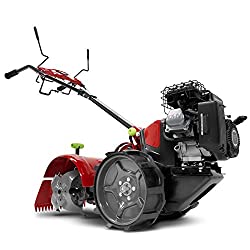
The dual direction rear tine tiller from Pioneer has an intriguing design. Let alone the performance. It lures you into buying just for the looks. However, the other features like wide-body design and a flat front to the back structure are some of the most likable features about this machine.
Airless wheels have a comprehensive design to move the equipment on any terrain efficiently. With an instant sliding of the shift handle, you can move back and forth with ease. You can also adjust the depth settings as per your need.
The one-hand control is another prime feature of this machine. The engine is much lighter than some of the other models. Yet, it is powerful enough to do a thorough job with any type of soil.
For its price range, it is one of the best options. A balanced design with a quieter and lighter engine lets you cut through tough soils smoothly and quietly.
Highlighted Features
– Airless wide tires.
– Balanced design for a smoother drive.
– One-hand control with dual grip handles.
– Competitive price range.
– Adjustable depth settings.
4. Dr Power Tw17016dmn Rear Tine Rototiller
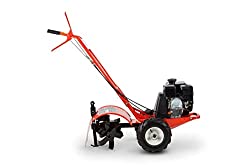
With a powerful 212cc OHV engine, the Dr. Power TW17016DMN is another excellent option for rototiller lovers. It works at an astounding 3700 RPM to ensure deep tilling with utmost convenience.
Whether it’s free-wheeling or power driving, the pneumatic wheels make sure that they run smoothly on any terrain or surface. The wheels have 13-inch pneumatic tires to provide better grip and balance to the tiller.
You can till up to 11 inches deep at an 11-inch width. There are counter-rotating tines that ensure aggressive tilling action to break through sod and hard rocks.
Moreover, the debris shield ensures that the engine and gear drive is well-protected during heavy-duty jobs. So, it’s an excellent option for both residential and commercial use.
With an excellent two-year warranty, this best rear tine rototiller ensures reliability and guaranteed performance with efficiency.
Highlighted Features
– 3700 RPM Engine.
– 11-inch tilling depth.
– Counter-rotating tines.
– Free-wheeling option.
5. YARDMAX YT5328 Compact Front Tine Tiller
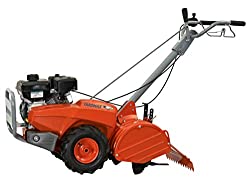
The Best Yardmax Front Tine Tiller YT5328 is a unique tine tiller on our list. Unlike the other tine tillers , it’s a most suited to small gardens and residential use.
It features depth control to provide tilling depths from 7 to 11 inches. Moreover, you can adjust the tilling width to 11, 16, or 21 inches, thanks to its removable tines. Therefore, it’s an all-in-one solution for small and big yards.
The engine is a 98cc Yardmax engine that can provide up to 180 RPM. You can adjust the height to make the operation more convenient. Moreover, the handlebar control operations can make your tilling control smoother on the go.
It’s rust-resistant. So, it will last longer, and therefore, it’s easy to store and move around. If you perform tilling jobs recursively, then it’s an ideal option to have.
Highlighted Features
– Up to 11-inches tilling depth.
– Tilling width adjustability.
– 180 RPM rotational speed.
– Fender to protect the user.
– Ball-bearing gear drive.
– Rust-resistant material.
Why Use A Rear Tine Tiller?
The are other ways to perform tilling too. However, none of them are as efficient as with the tine tillers. Also, rear tine tillers are much handier than the other types in many situations. So, if you’re wondering when a rear tine tiller will be the best option, here are some reasons:
- Power: As compared to front tine tillers, Rear tine tillers are much more powerful. Hence, they can cut through most types of rocks and soil where other tillers may fail. They can easily loosen stony soils and clay-based muds. So, if you have a virgin farming area, a rear tine tiller will suit you most.
- Commercial Grade Performance: As we just saw, power is a must-have element if you want a tiller for professional services. Understandably, the rear tine tillers are slightly more expensive than the others. However, you can still get some of the best rear tine tillers under $1000.
- Regular Tilling: Regular tilling can make the soil softer and more comfortable to dig. So, rear tine tillers are the best to work recursive jobs. However, if tilling is just a one-time requirement for you, you don’t need to buy a tine tiller. Get a rental service to do the job for you.
- Handling: Rear tine tillers are powerful equipment, so there is some degree of difficulty in operating these machines. In this regard, best front tine tillers are more comfortable and lighter. However, you may have to compromise on performance and efficiency.
- Ease of Use: There are many conventional methods for tilling, but they come at a high cost. Tilling ground with old ways can be tiresome, time-consuming, and often cause injuries. Tine tillers ensure that you can dig any type of soil with minimum effort. Moreover, there are safety mechanisms and accessories, ensuring no accidents during tilling jobs.
Best Rear Tine Tillers Buying Guide
The Rear Tine Tiller options above are all worth your money. However, if you don’t know your priorities, it can be challenging to buy the right machine. The buyer’s guide will help you focus on the right features of a rear tine tiller so that you know what you’re looking for.
Tilling Depth
Tilling depth is an essential consideration for any tilling job. It directly affects the price because commercial tilling rests on how deep you can till. Most of the modern tine tillers come with depth adjustment features. Since each seed requires a different depth, you get more control as a user.
Therefore, when you’re buying a rear tine tiller, look for depth adjustability. Most tine tillers can go as deep as 10 to 12 inches. Some uncommon models can go beyond that, but they can be too costly.
Tilling Width
Tilling width determines how fast you can complete a tilling job. The greater the tilling width, the quicker the tilling job will end. Since larger width can help shred more ground at once, such tillers are used for commercial setups.
However, the larger width is a tradeoff for maneuverability, as the tiller may not access smaller areas. To solve this problem, many modern rear tine tillers have adjustable tine widths.
The average tilling width is around 15 to 20 inches. Popular machines like the Husqvarna tiller fall into this category. Also, some high-end tillers can go up to 36 inches tilling width. On the contrary, some tine tillers start at 7 inches, which is useful if you have a small tilling area.
Starting Mechanism
There are two types of starting mechanisms, i.e., manual start and electric start. Most traditional tillers have a manual starting mechanism. So, you must pull the cord and start the engine. It’s the cheaper option of the two.
On the other hand, electric starters come with a sophisticated ignition system, so you push a button to start your machine. It’s more convenient, but of course, the price is higher. So, if there are no budget constraints, you can invest a few hundred bucks to get an electric start tiller.
Tilling Engine
The engine is the most critical element in a tiller. It directly affects the machine’s performance, durability, and efficiency, so it’s worth the central portion of your investment. If you compromise on the engine quality, you are likely to face repair costs.
Generally, tiller engines are either two-stroke or four-stroke. Four-stroke machines are a preferred choice because they produce fewer emissions as there is a gas-oil mixture that lubricates the internal mechanism. Moreover, they are quieter, more efficient, and powerful.
Therefore, if you have the budget, always go for four-stroke engines to serve you longer. Modern tine tillers mostly have four-stroke machines.
Engine power is another crucial factor. A regular tilling engine can start as low as 98cc and go up to more than 200cc. So, if you’re working with more challenging terrains, you will need more power to till through at more considerable depths.
A low-power engine such as the Yardmax rear tine tiller will be most suitable for small gardens and pre-tilled grounds.
Self-Sharpening Tines
The tines are likely to wear out after a while. This is particularly true for commercial tillers because they perform regular jobs. In such cases, older tillers required the removal of tines for sharpening. However, modern tillers like the Southland rear tine tiller have self-sharpening tines.
So, the counter-rotating tines sharpen as they cut through the ground. Therefore, you no longer need to detach the tines, which saves much effort and time. So, if you want to prevent maintenance costs, self-sharpening tine tillers are the way to go.
Tire Size
The tires bear the entire weight of the machine. Also, they must move through uneven surfaces as the tines dig through the ground. So, the tires deserve careful consideration while selecting a rear tine tiller.
If you have the right tires, it is easier to maneuver the machine. So, you get better control while driving on any surface. The correct tire will have treads to allow better gripping on clay and soft soil. Moreover, pneumatic tires are the preferred option to find them in most rear tine tillers.
However, some tine tillers also have airless tires, so it’s all about what you want. Make sure that the tire width is at least 13 inches. It’s a standard that most manufacturers follow.
How Tines Rotate
Tine rotation impacts the aeration in your soil. Of course, you want more air to reach the earth, and it’s possible if the tines shred the soil thoroughly. Also, tine rotation has a direct relation to the nature of the ground.
Firstly, there are counter-rotating tines. These tines provide better stability and control to the tines. There are multiple rotating types. If your garden has clay-based ground, then counter-rotating tines will work best.
Secondly, there are forward rotating tines. These tines can easily cut through rocky surfaces. They work best for rocky grounds.
Adjustable Handlebars
Ergonomics is the key to pain-free tilling jobs. The last thing you want is a sore back after tilling. Therefore, adjustable handlebars are more convenient because you can adjust the height accordingly. So, you can move the tiller more comfortably.
The only tradeoff is that that fixed handlebars generally last longer. However, it’s still a preferable option if you prefer convenience over money.
Gear Transmission
Earlier tine tillers had only one-directional gears. It was quite inconvenient, especially with heavier models. However, modern tillers have both forward and reverse gear options. So, it’s best to buy them because they reduce human effort, and you can perform the job quicker.
Such tine tillers may be more expensive, but they are more efficient and durable. Moreover, a right tine tiller must have a neutral gear because you always need to free-wheel on your field.
There is also a speed adjustment feature in some tillers. However, it’s a secondary feature and generally not preferred by experts.
Counterweight
The counterweight is an additional feature that you won’t find in every rear tine tiller. However, it’s a safety option worth considering. The counterweight adds more balance to your tiller.
You can also experience sudden jerks as you till, so a counterweight also prevents the tillers from sudden jerking action.
Drag Bar
Another additional feature is the drag bar. The drag bar helps in maintaining the tilling depth. So, it helps to till more consistently. The drag bar attaches to the rear of the tiller.
Budget
Finally, all your considerations will depend on how much you’re willing to spend on your rear tine tiller. It is essential to understand that a tine tiller performs a valuable job. So, it’s worth the investment.
Rear tine tillers can cost between $500 to $3000. Generally, you can get a good deal for a tine tiller for under $1000. Budget constraints can often compromise some aspects, so you must prioritize engine quality and tine rotation.
Conclusion
Whether it’s landscaping for fun or digging for a veggie garden, a rear tine tiller can do all your jobs with ease. The best rear tine tillers not only reduce the workload, but they also help in tilling cleanly with precision. Also, they save some precious bucks that go on labor.
Now that you know the best options, it should be much easier to select the machine of your dreams. On top of that, you know the basics of this equipment. So, when you go for an upgrade, you can tick the right boxes to buy the most suitable product.
One thing is sure that it’s time to say goodbye to the worrisome tilling jobs. You won’t need to deal with rental services, stubborn soils, and unexpected rocks because your rear tine tiller can take care of them all.
So, plan a budget, and keep your priorities straight. If you go by our word, you won’t be disappointed.
Frequently Asked Questions
Rear Tine Tillers offer a lot of comfort and efficiency. You now know the most critical elements the customers want to learn about. However, there are always some questions between the lines. Here are some frequently asked questions about tine tillers:
Q.How Does A Rear Tine Tiller Function?
A rear tine tiller can work on gasoline or electric power. Electric rear tine tiller is less powerful and can have both wired and wireless options.
In rear tine tillers, you will find a pair of wheels in the front. The user operates with the handles as they apply gear and move the tiller forward. As the wheels move forward, the tines rotate in the opposite direction. So, the tines drill through the ground making wide holes with minimal effort.
Q.Are Rear Tine Tiller Better?
It depends on your need. Rear tine tillers are better than front tine tillers for two reasons. Firstly, they can be much more powerful, and you can cover larger fields in a shorter time. However, rear tine tillers are more expensive too.
So, your priority decides whether you want comfort and efficiency or compromise for money.
Q.How Deep Can A Rear Tine Tiller Dig?
An average rear tine tiller can dig up to 10 inches. However, some commercial-grade high-performance tillers can dig close to 15 inches.
Some tine tillers come with the height adjustability feature, so there is a variable height range. So, if you’re testing a tiller, start with external adjustments and gradually increase the depth in every pass.
Q. How Much Does It Cost To Rent A Rear Tine Tiller?
An average rental cost of a rear tine tiller is around $50 to $60 per day. Companies also offer different packages for weekly usage.
Rental tine tillers are an excellent option if you need a one-time job. It’s best to pay for the service once rather than handling and maintaining a much more expensive gadget.

